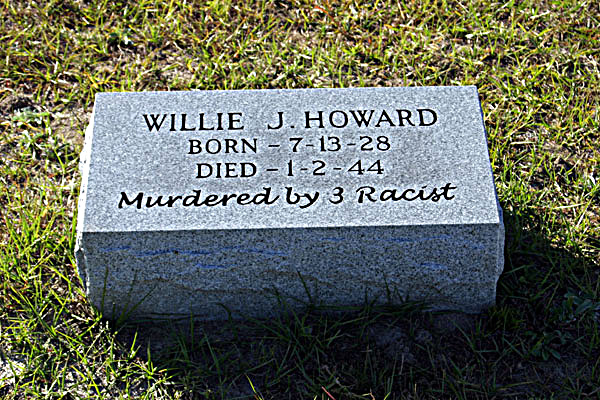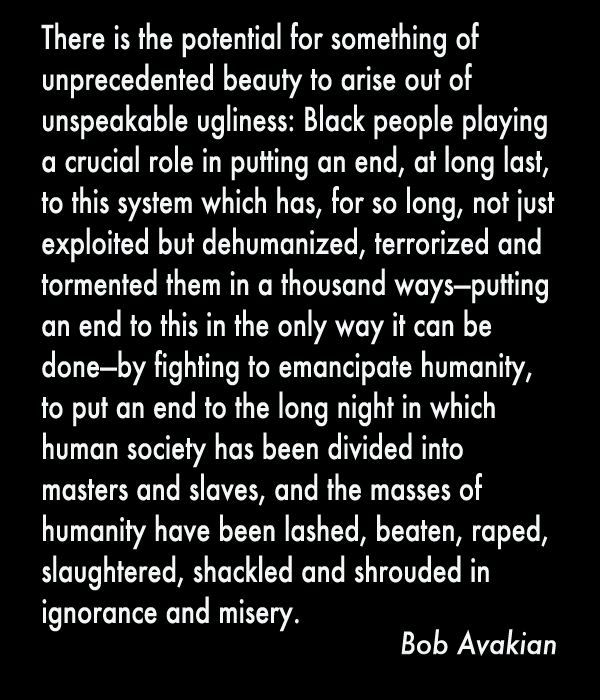Case #33: The 1944 Lynching of 15-Year-Old Willie James Howard for Writing a Christmas Card to a White Girl
| Revolution Newspaper | revcom.us
Bob Avakian has written that one of three things that has "to happen in order for there to be real and lasting change for the better: People have to fully confront the actual history of this country and its role in the world up to today, and the terrible consequences of this." (See "3 Things that have to happen in order for there to be real and lasting change for the better.")
In that light, and in that spirit, "American Crime" is a regular feature of revcom.us. Each installment will focus on one of the 100 worst crimes committed by the U.S. rulers—out of countless bloody crimes they have carried out against people around the world, from the founding of the U.S. to the present day.
See all the articles in this series.
THE CRIME
In December 1943, Willie James Howard, a 15-year-old Black youth, was in the 10th grade in Live Oak, Florida, and working at the local dime store. For Christmas, Willie James gave cards to all his co-workers, including a 15-year-old white girl named Cynthia Goff. He signed the card to Cynthia “with L.”
Apparently, Willie James heard that Cynthia was upset about receiving the card. On New Year’s Day, he delivered a second note to explain, saying, “I know you don’t think much of our kind but we don’t hate you all. We want to be your friends but you won’t let us... I wish this was [a] northern state. I guess you call me fresh. Write an[d] tell me what you think of me good or bad... I love your name. I love your voice, for a S.H. [sweetheart] you are my choice.”
Cynthia showed the note to her father, A. Phillip Goff, a former state legislator. On January 2, Goff and two other white men, S.B. McCullers and Reg H. Scott, drove up to Willie James Howard’s house. Willie’s father, James, had left for work at the lumber company. Willie’s mother, Lula, said in an affidavit she provided later that when her son came home, Goff grabbed him and ordered him to come along. According to Lula Howard, “I tried to pull him away, and also kept pleading and asking what Willie had done. By this time Mr. Goff had pulled a revolver out from somewhere on his person and leveled it at me. He dragged Willie out to the car, got in with the other white men, and drove off....”
The three white men with their young captive then drove to where Willie’s father, James Howard, was working and forced him into the car as well. Then Goff and his friends drove Willie James and his father to the banks of the Suwannee River. According to testimony that James Howard gave to an attorney later, Goff and others tied Willie’s hands and feet and forced him to stand at the edge of the water. Then the white men gave Willie a “choice”—be shot to death, or jump into the river. Willie, with his hands and feet bound, jumped into the cold waters of the Suwannee and drowned.
The next morning, the town’s Black undertaker was told by the sheriff to retrieve Willie James Howard’s body from the river. The body was immediately buried in an unmarked grave at the “coloreds only” Eastside Cemetery. Goff gave a statement to the sheriff denying he and his two friends had murdered the Black youth.
Fearing for their lives, James and Lula Howard and their family fled from Live Oak and moved to Orlando a few days after Willie James was lynched. A woman who was in Live Oak at the time recalled decades later, “We found out at school the next day. It was so scary, but that was in the 1940s. We thought the KKK were coming to get the rest of us.”
An attorney visiting Live Oak at the time heard about the lynching and brought it to the attention of the NAACP. The NAACP demanded that Florida Governor Spessard Holland open a full investigation.
The grand jury did not return any indictments against Goff and his accomplices. The U.S. Justice Department refused to intervene. No one was ever punished for the lynching of 15-year-old Willie James Howard.
THE CRIMINALS
A. Phillip Goff, a former Florida state legislator, S.B. McCullers, and Reg H. Scott, the three white men who carried out the lynching.
The Live Oak grand jury, which issued no indictments for the lynching of Willie James Howard.
Florida Governor Spessard Holland, who replied to NAACP’s demand for a full investigation into the lynching of Willie James Howard by sending them Goff’s denial of any responsibility and warning of “particular difficulties involved where there will be testimony of three white men and probably the girl against the testimony of one Negro man.”
U.S. Justice Department, which declined to act on demands for investigation and charges in the lynching of Willie James Howard.
THE ALIBI
Phillip Goff admitted he and his friends had taken Willie James and his father to the banks of the river and tied up the youth’s feet. He claimed they wanted the father to whip his son “for his misdeed,” writing the letter to Goff’s daughter. But, Goff said, the boy jumped into the river to avoid a whipping. In other words, this lyncher claimed that Willie James Howard had killed himself.
THE ACTUAL MOTIVE
The lynching of Willie James Howard and thousands of others are part of the reality of American society. Even after literal slavery was ended through the Civil War, the horrors of oppression continued for Black people in new forms—and lynching and its effects were a certain concentration of what the masses of African-Americans faced. For decades under the overt segregation known as Jim Crow in the South, every Black person there faced the threat that at any time they could be brutally murdered for anything they did that might “offend” some white people—or for nothing at all except the color of their skin—and nothing would happen to their killers. This was a key way that white supremacy and the subjugation of Black people were enforced.
It is not just that the whites who carried out these lynchings were racist monsters. These murders and other atrocities were rooted in, and served to keep in place, a whole system in this country. This is a system that could not have existed without first slavery and then near-slavery of millions of Black people—a system with white supremacy built into its foundations. And segregation of and discrimination against Black and other oppressed people continue down to today, from jobs and education to housing, health care, and all parts of society—and this continues to be backed up by official and unofficial violence and brutality.
In Lynching in America: Confronting the Legacy of Racial Terror, the Equal Justice Initiative documents over 4,000 lynchings of Black people between 1877 and 1950 in just 12 Southern states. This number represents only the number of known lynching deaths—many, perhaps even most, went unreported or were covered up.
The murder of 15-year-old Willie James Howard took place 11 years before the torture and lynching of 14-year-old Emmett Till. Willie James was lynched by white men outraged at a Black youth writing a Christmas card to a white girl. Emmett was lynched by white men outraged at a Black youth whistling at a white woman.
Sources:
* “Willie James Howard Lynching,” from the website for the PBS program Freedom Never Dies.
* “Willie James Howard,” Northeastern University School of Law Civil Rights and Restorative Project.
* “60 years later, a cry for justice in Fla. killing: Black teen who liked white girl was taken at gunpoint and drowned in Suwannee River,” by Audra D.S. Burch, Baltimore Sun,December 10, 2006.
* “Before Emmett Till’s Death, Willie James Howard, 15, Was Murdered in Fla,” by Tonyaa J. Weathersbee, The Root,August 29, 2015.
* “Episode 7: Christmas Lynchings,” The Color Line Murders podcast.
* “Three Christmas Day Lynchings,” thiscruelwar.com.
* Lynching in America: Confronting the Legacy of Racial Terror, the Equal Justice Initiative.
* “Emmett Till and Lynchings, Past and Present,” revcom.us, an excerpt from the 2003 talk, Revolution: Why It’s Necessary, Why It’s Possible, What It’s All About, by Bob Avakian.

Bob Avakian: "Emmett Till and Jim Crow: Black people lived under a death sentence"
An excerpt from REVOLUTION: Why It's Necessary, Why It's Possible, What It's All About. Watch the whole talk at revolutiontalk.net.

Other Christmastime Lynchings
According to the website thiscruelwar.com, there were more than 70 lynchings of Black people in the week of December 19 to 25, from 1877 to 1950. As the compiler of the list notes, this number is incomplete because of unreported lynchings and inadequate databases.
Among the lynchings that took place on Christmas Day itself are the following:
* 1901, Prairie Blossom, Texas—J.N. McClinton, a Black minister and farmer, shot to death on the doorway of his own home.
* 1906, Kemper County, Mississippi—After a police officer was killed shortly before Christmas, George Simpson, a Black man alleged to be the suspect, was lynched. A white mob then lynched Simpson’s two sons. The murders of Black people by the racist posses continued, including the lynching of Colvin Nicholson on Christmas, described by a newspaper account at the time as “one of the most brutal, which has occurred since the days of Reconstruction.”
* 1928, Jackson, Louisiana—In an alleged dispute over a hunting dog belonging to the owner of a plantation, a group of white men attacked the family of Bob Taylor, a Black tenant on the plantation. They murdered Taylor’s 15-year-old and 20-year-old daughters and wounded another daughter and their mother.
Get a free email subscription to revcom.us:


